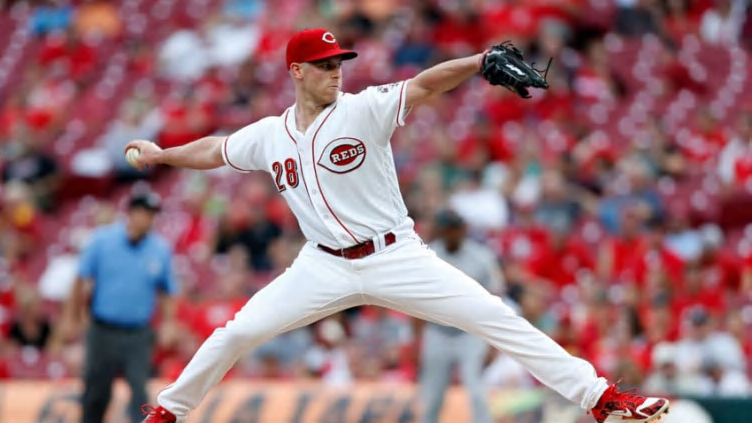Cincinnati Reds: The long ball has doomed Anthony DeSclafani

The Cincinnati Reds pitching staff has been successful limiting home runs all season, except for Anthony DeSclafani. He takes the hill tonight in St. Louis.
Since Anthony DeSclafani was acquired in December 2014 from the Miami Marlins for Mat Latos, he has been an important part of the Cincinnati Reds starting rotation. DeSclafani was one of the lone bright spots on the historically bad pitching staff the Reds employed from 2015-2018. However, the recent upgrades to the rotation have Disco looking like the weak link.
Before this season, DeSclafani produced solid numbers even though most of the Reds’ staff failed to perform. In 2015, his first with the Reds, Disco had a 4.05 ERA and a 3.67 FIP in 184.2 innings. In 2016, he was injured at the start of the season but ultimately had a great season. DeSclafani had a 3.28 ERA and a 3.96 FIP in 123.1 innings.
Unfortunately, 2017 was a lost season for Anthony DeSclafani. Disco was injured for most of the season. He went on a rehab assignment in the minors but ultimately was shut down for the season without making an appearance in the big leagues.
José Peraza shows value in Reds' 4-1 win. More
Last season, DeSclafani missed the first two months of the season, but he did make his season debut in June. DeSclafani struggled more than he had during his entire Cincinnati Reds career. He finished the season with a 4.93 ERA and a 4.83 FIP in 115 innings.
This season, outside of a couple of starts, has been a struggle for Anthony DeSclafani as well. He currently has a 4.97 ERA and a 5.57 FIP in 54.1 innings. What has happened to Disco? If you look at his stats from 2015-2016 and compare them to 2018-2019, the clear problem is the long ball.
In 2015, DeSclafani gave up 17 home runs in 184.2 innings. In 2016, he gave up 16 home runs in 123.1 innings. Those aren’t bad numbers, but there was an increase in his home run rate from 2015 to 2016.
Last season, Disco’s home run rate went up even more. DeSclafani allowed 24 dingers in 115 innings. So far this season, it hasn’t been any better for Anthony DeSclafani as home run rate continues to climb. He has already allowed 14 home runs this season in only 54.1 innings.
Surrendering the long ball is obviously Disco’s biggest problem, but why is this happening? Well, there are many factors. First, he pitches half his games in hitter friendly Great American Ball Park where home run balls fly out often. However, that doesn’t tell the whole story and we’ve yet to reach the middle of summer when balls will likely leave GABP at an alarming rate.
We live in an age where launch angle and hitters lifting the ball is becoming more common from team to team and from player to player. Thus, the home run numbers in baseball continue to go up.
In fact, it seems as if there is a new record for home runs in baseball every month and year that passes. This May saw more balls leave the yard than any month in the history of the sport. A total of 1,135 homers were hit in May, breaking the previous record of 1,119 set in August of 2017.
Even though Disco has no control over what era he pitches in, his pitching style certainty isn’t doing him any favors. Anthony DeSclafani has long been considered a fly ball pitcher, a problem if he’s not locating his pitches correctly.
Through his first two seasons with the Cincinnati Reds, he was a fly ball pitcher and his ground ball to flyball ratio would indicate that. In 2015, he had a 0.83 GB/FB ratio. In 2016, he had a 0.74 GB/FB ratio.
As Disco’s Reds’ career goes on, his GB/FB ratio has continued to show that he produces more fly balls than ground balls. Last season, the GB/FB ratio showed this trend by dropping to 0.72. This season it has dropped even more dramatically to 0.56 GB/FB.
Now, this isn’t a bad thing for a pitcher to be a fly ball pitcher rather a ground ball pitcher, as both styles can work, but more fly balls given up equals a better chance for more balls to go over the wall. Ultimately, pitching style is hurting Disco and leading to him giving up more home runs.
If there is a silver lining to DeSclafani’s struggles with the home run ball, it is that of the 14 home runs he has given up so far this season, 9 have been of the solo variety. So, if DeSclafani can continue keeping the home runs to just solo shots, he may be able to be survive even with an outrageous amount of home runs give up.
Bronson Arroyo always gave up a lot of home runs during his Cincinnati Reds’ career but he still was successful throughout his time in the Queen City. I’m not saying DeSclafani will be as successful as Arroyo but if he can keep the traffic off the bases when he gives up home runs, I think he can be.
Reds Top 10 round-by-round draft picks of all-time. Next
If DeSclafani continues to struggle and starts to compound his mistakes by giving up homers with men on base, he may be the odd man out in the starting rotation when Alex Wood comes off the injured list. Disco may be ticketed for the bullpen if he doesn’t get his home run problem under control.